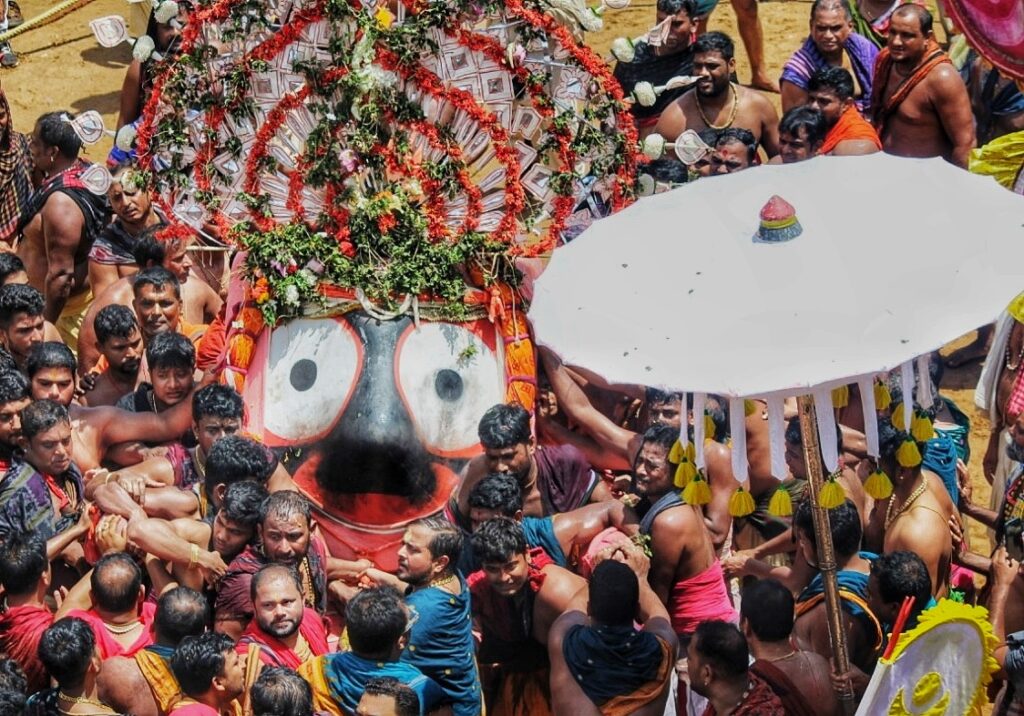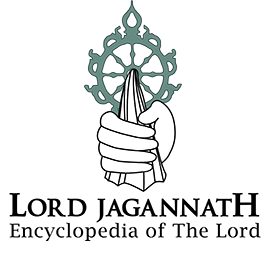The Antiquity of Jagannath Mahaprabhu

There’s a couplet in Rigveda, the most ancient text of the world which was written probably four thousand years ago –
Ado Yaddaru Plavate Sindhoh Pare Aparusham
Tada Rabhasva Durjano Tena Gachha Parastram
Sayanacharya, a saint who flourished in the 14th century had interpreted these lines in this way,
There exists in the sea shore in a far off place the image of a deity of the name of Purosottam which is made of wood floating as if it were in the sea. O, ye, by worshipping that wood indestructible attain the supreme place of the Vaishnavite.
In the ancient epic Mahabharata (Vana Parva, Chapter-114, Slokas 22-24) there’s the mention of vedi (platform) near the Kalinga sea.
In the course of their banishment, the Pandavas traveled all over India and in the course of their journey, they crossed the river Baitarani (in Odisha) and entered Kalinga (the ancient name of Odisha). The sage Lomasha told the Pandavas the story of a yagnya which was performed by Vishwakarma, the Engineer of the Heavens. There, he offered the Earth Goddess as a present to Saint Kashyapa. Treated so disrespectfully, Mother Earth disappeared into the netherworld. Saint Kashyapa went through a period of penance, and thereafter Mother Earth appeared as a platform near the sea by Puri. It appears there was some huge platform near the sea during the time of Mahabharata (written at least 3 millennia ago).
Multiple scholars, both domestic and foreign, identify Jagannath Mahaprabhu with Bhagwan Buddha. Writing in 717 CE, Indrabhuti, the King of Uddyana and the founder of the Buddhist sect Vajrayan, begins his Jnanasiddhi with the following prayer to Mahaprabhu Jagannath:
Pranipatya Jagannatham
Sarvajnanavarachitam
Sarva Buddhamayam Siddhivyapinam Gaganopaman!
A few scholars like Pandita Nilakantha Das who wrote extensively on Jagannath cult identified Jagannath with Jainism and in support offered multiple evidences from history and literature.
Huyen Tsang the most famous Chinese tourist who visited in the 7th century CE had written about a massive idol of Mahabir Jina by the sea of Puri. Jainism was a flourishing religion: It’s written that the King of Magadha Mahapadma Nanda took away by force an idol of Mahabir in 4th century BCE. After six centuries, the greatest emperor of the land, Kharavela avenged the insult and brought back the stolen idol.
Pandit Nilakantha Das identified Jagannath with the first apostle of Jainism, Rishabhanatha.
Bhagwan Mahavira Jain flourished at least half a century before Bhagwan Buddha. He’s regarded as the 24th Guru of the faith which was founded by Rishabhanatha. If Jagannath is Rishabhanatha then His antiquity was lost in time. Hindus believe Rishabhanatha to be an avatar of Bhagwan Vishnu. The phonological similarity between Jagannath and Jina, the concept of Kaibalya, the similarity of Ratha Yatra which takes place on the second full moon day of Aasaddha (the fourth Hindu month) which also happens to be the birthday of Rishabhanatha speaks of the affinity between the two.
Pandita Nilakantha Das in his seminal Gita Prabesh (a commentary on Bhagvat Gita) stated that the cult of Jagannath was there in Babylon civilization. The speaker of Odisha legislative assembly and a scholar extraordinary, he said this in the assembly.
‘If any one wants to investigate the symbol, he would see that it started with Babylon civilization…which is still there.’
Even today there’s a stone image of Mahavira on the wall of Beharana Door. It is said that this idol was besides the Pearl Throne till the beginning of 20th century which was then replaced to its present position.
Finally, the legend of the tribal origin of Mahaprabhu. It’s believed that Jagannath was worshiped by Sabaras (a caste of hunters) in far-off Koraput district. In fact some of the most referred and established literature by many eminent cultural historians like A Eschmann, Herman Kulke, BN Padhi believe in the tribal origin of Jagannath cult. Even today Jagannath in Sabara villages is known as Jaganaelo (made of wood) and is worshiped as the God of the Universe.
A Eschman believed, and with him Pandita Nilakantha Das, BN Padhi and many others, that Jagannath was a tribal god whose Aryanisation happened much later.
The massive temple was built in the 12th century. Such a massive temple couldn’t have come up without a flourishing Jagannath cult. Many believe the Adi Nrusimha temple besides Mukti Mandap was the original temple. It is believed that the temple was at least four hundred years older than the grand one.
In conclusion, we can say that the cult of Jagannath is truly a world religion of sorts with its roots stretching to Babylon in space and to Austric tribes in time.
There in Him you can find Bhagwan Rishabhanatha, Bhagwan Buddha, the wood-worshipping cult of the Austric groups, and of course the Aryan God, Bhagwan Sri Krishna (whose heart is said to be the Brahma, the life-force hidden in the idols).
(All the information in the article is borrowed from multiple sources and is very much known by the public, and scholars. My gratitude to all of them)
Jai Jagannath!
